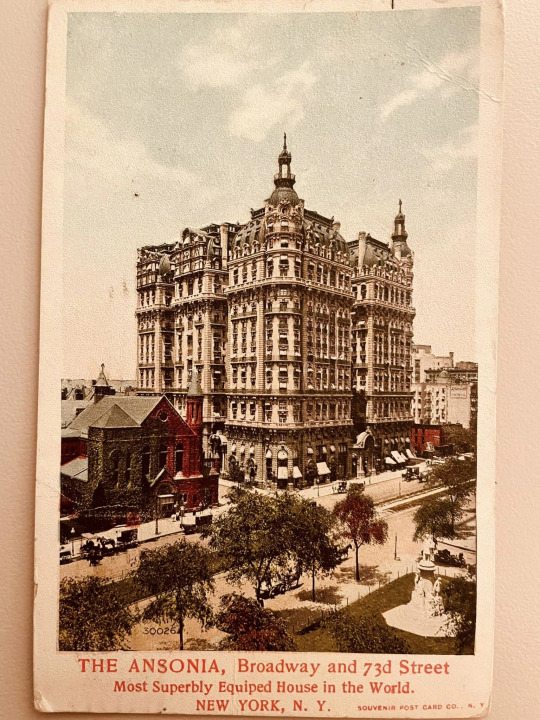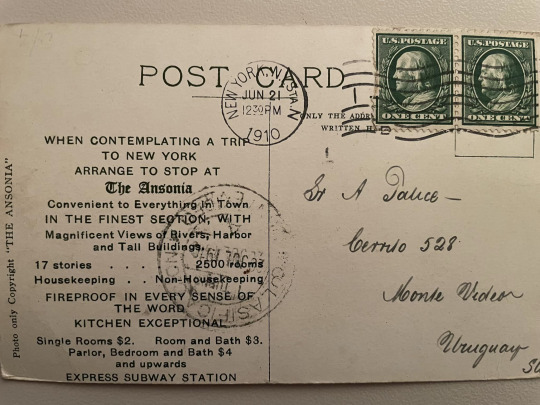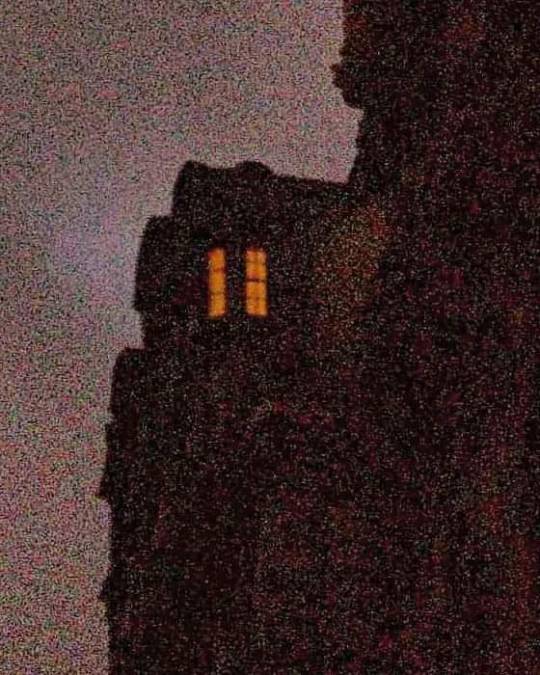#The Ansonia Hotel
Explore tagged Tumblr posts
Text


Today a old postcard from 1910 New York.
The Ansonia Hotel was since 1904 a very exclusive place. The greatest stars have living there: Eleanor Steber, Geraldine Farrar, Lily Pons, Feodor Chaliapin, Ezio Pinza, Lauritz Melchior, Arturo Toscanini and Igor Strawinsky are only a small part of great names. When was season at the MET this was the home of important Personalitys. Take a look on the History of this Hotel. For better reading click on the pics.
#The Ansonia#The Ansonia Hotel#Hotel#Sam Franko#conductor#Arturo Toscanini#Igor Stravinsky#composer#Antonio Scotti#baritone#Tito Schipa#lyric tenor#tenor#Lily Pons#lyric coloratura soprano#coloratura soprano#soprano#Geraldine Farrar#lyric soprano#Feodor Chaliapin#bass#Enrico Caruso#dramatic tenor#Frances Alda#Ezio Pinza#Lauritz Melchior#heldentenor#poatcard#opera#historian of music
7 notes
·
View notes
Text

... stained glass ....
Louis Comfort Tiffany, Landscape Window from the Ansonia Hotel New York, 1904-1910.
8 notes
·
View notes
Text

The #Ansonia_Hotel, #Manhattan at #dusk
20 notes
·
View notes
Text
Steve Ostrow OAM's memorial to be held on April 13
New Post has been published on https://qnews.com.au/steve-ostrow-oams-memorial-to-be-held-on-april-13/
Steve Ostrow OAM's memorial to be held on April 13

Steve Ostrow dedicated years of service to the Sydney LGBTQIA+ community after moving to Australia in his 50s.
Mature Age Gays (MAG) social group founder and Medal of the Order of Australia recipient Steve Ostrow died in his retirement home aged 91 on February 4 and will be remembered as a pillar of the LGBTQIA+ community in Sydney for many years to come.
Ostrow was bisexual and was born in Brooklyn to Russian Jewish immigrant parents in September of 1932 where he served as a cantor in his local synagogue.
Later in life he would speak of the “confusion and frustrations” he had often felt as a bisexual man, “not understood by the gay or the straight world.”
As a young man he studied singing at the Henry Street Settlement in Manhattan before joining the New York City Opera.
There he met the American opera singer Joanne King who was his co-star in La Bohème.
They married in 1960 and had two children, Scott Ostrow and Maria Jaul, before divorcing in the 1980s.
The Continental
In 1968, Steve Ostrow opened The Continental Baths in the basement of New York’s The Ansonia Hotel, which quickly became the most popular gay venue in the city.
Ostrow opened The Continental after witnessing the conditions in other New York gay bathhouses, which he would later describe as “”sleazy, secretive, unkempt, not to mention unfriendly.”
Ostrow had a different vision, of “a gay fantasia,” “a palace devoted to hedonism,” reminiscent of “the glory of ancient Rome.”
There was a line to get in that snaked around the corner from the opening night and some patrons would boast of having 150 sexual encounters in a single visit.
Ostrow also installed a stage for DJs that some have claimed to be the first of its kind in the world and had Larry Levan and Frankie Knuckles spinning tunes for patrons.
He also had live performers at The Continental and is credited with kickstarting the careers of stars including Bette Midler, Barry Manilow, Labelle, The Manhattan Transfer and Peter Allen among many others.
Mildler and Manilow would perform together, with Manilow on piano, and Midler debuted her early hit Friends at The Continental and later released an album inspired by them, Bathhouse Betty.
However the popularity of the entertainment at The Continental was a two edged sword for the venue and the gay crowd dwindled as more and more straight people began attending for the shows.
Ostrow cancelled the live music at The Continental in 1974 but it was too late for the venue and it ultimately closed in 1976.
Recalling The Baths in 2007, Ostrow wrote, “The Continental was a phenomenon that came out of a pre-AIDS world that we will probably never experience again.”
“But more than just being a bathhouse and showplace, The Baths were a place where people came out of their closets and found out who they were. It was the first gay establishment to treat gay people as equals and not exploit them.
“It was instrumental in having the laws against homosexuality rescinded and gave birth, along with Stonewall, to a whole generation where gay was in.
“Beyond that it ushered in an era of sexual liberation and alternative lifestyles that, to this day, has never been equaled.”
Life in Australia
Ostrow had continued his career as a performer in parallel to operating The Continental and performed in operas for major music companies including the San Francisco Opera, Germany’s Stuttgart Opera and the Australian Opera which ultimately lead to him moving to Sydney in 1987 following his divorce.
In Sydney he worked as a vocal coach director at the Sydney Academy of Vocal Arts after eight years with the Ausralian Opera, before founding the group Mature Age Gays as a safe place where older gay, men could meet and socialise on his 59th birthday on September 16, 1991.
“Once AIDS came in, I became a volunteer operator on the hotline for ACON, the AIDS Council of NSW,” he recalled in 2013.
As part of that community work, Ostrow was tasked with identifying the needs and concerns of gay men over 40.
“Most of the health campaigns back then focused on young men, telling them ‘wear a condom, wear a condom,’” he said.
“However what [the men over 40 were more concerned about] was isolation, loneliness, estrangement from family and loss of partners.”
Ostrow remained president of Mature Age Gays until 2013 and also worked and volunteered for ACON over many years as well as being an LGBTQIA+ rights activist.
Ash Rehn, a former Education Manager at ACON in the early 2000s, recalled being given the task of convincing Ostrow to take his annual leave which had been accumulating over a number of years.
“Steve sat me down and gave me a brief history of his life,” Rehn wrote, following Ostrow’s passing.
“He didn’t have to do that and I’m grateful that he did. Not only did he have a clear rationale behind the way he went about his projects, he had commitment as well. He was a standout guy. If Steve wanted to do something, he was going to do it.”
“They can stop paying me but I won’t stop working!” Rehn recalled Ostrow telling him.
“That was who he was. I think we came to some arrangement about reducing hours on paper that, thankfully, I didn’t have to monitor. I hope he continues to be an inspiration to others both within and outside of the organisation.”
In 2007 Ostrow released his memoir Live at The Continental: The Inside Story of the World-Famous Continental Baths and in 2021 he was awarded a Medal of the Order of Australia (OAM) for his work advancing LGBTQIA+ rights causes throughout his life.
Ostrow remembered
ACON President Nicholas Parkhill said Ostrow’s death was being felt throughout the organisation.
“Steve’s passing is being felt by many at ACON given his time with us, and it’s a sad and great loss for our community as a whole,” Parkhill said.
“Steve was a longstanding and much-loved member of the team at ACON during the late 1980s and early 90s, where he volunteered on support helplines and worked on safer sex campaigns during the most harrowing and challenging times of the HIV/AIDS epidemic.
“Steve was also a pioneer for many in our communities. He established the Mature Aged Gays project in 1991 – an organisation of which continues to flourish today and provide much needed support for older men in our communities.
“Many of us at ACON feel lucky to have met and worked alongside Steve, and we remain incredibly grateful for, and will never forget, all the work that he did for our communities, not to mention his charm, kindness, flair, and compassion.”
Mature Age Gays will celebrate their 33rd anniversary in September.
-A memorial service for Steve Ostrow OAM will be held on Saturday, April 13 at Pitt Street Uniting Church from 2pm to 4pm
For the latest LGBTIQA+ Sister Girl and Brother Boy news, entertainment, community stories in Australia, visit qnews.com.au. Check out our latest magazines or find us on Facebook, Twitter, Instagram and YouTube.
0 notes
Photo

Workmen preparing to lower one of the 100-pound metal cornices from the Hotel Ansonia on Broadway and 77th Street, September 22, 1942. The hotel scrapped thousands of pounds of its outstanding ornamental metal work to help in the war effort.
N.B. The Met site states that the hotel was designed by Stanford White, which isn’t true. The architect was Paul E. M. Duboy, assisted by the building’s developer, William Earle Dodge Stokes.
Source: My Modern Met
99 notes
·
View notes
Photo


The abandoned Hotel Ansonia of Detroit, Michigan, pictured here in 2007 & 2019. Built in 1926, closed in 2006, saved from demolition in 2017.
50 notes
·
View notes
Photo

Actress Mollie King in the Ansonia residential hotel in New York City, 1917. From her living room windows one looked down on Broadway.
90 notes
·
View notes
Photo

1914 c. View west across Broadway at 72nd Street at the Ansonia Hotel in New York City’s Upper West Side. Florenz Ziegfeld and Anna Held lived here for several years.
104 notes
·
View notes
Photo

Sep 21 1919 Group of White Sox ballplayers meet in Chick Gandil's room at the Ansonia Hotel in NYC. There they plan to intentionally lose the 1919 World Series against Cincinnati Reds in exchange for money from a gambling syndicate led by Arnold Rothstein
43 notes
·
View notes
Photo

Ansonia Hotel, upper west side, NYC
3 notes
·
View notes
Text

Madame TAMAKI Miura, the only Madame Butterfly whom one might call “to the manner born” in a racial sense, since the charming little prima donna is a Japanese artist, gave the writer many study and interpretation hints by which the student might profit, when he visited her at her apartments in the Hotel Ansonia in New York. First of all she made clear that there is a vast difference between native Japanese singing and the occidental art song as it is cultivated by a Japanese artist singer.
REAL JAPANESE SONG
“Real Japanese song is beautiful—if you have a Japanese soul with which to understand it. But I am afraid that if you have not, then it is apt to mean nothing at allto you. There is a great difference between the art songs of the native Japanese professional singers and the simple little folk songs which Japanese girls sing to their samisens or guitars. 'The professional singing is all very artificial, and when a professional street singer or a singer on the Japanese stage in Tokio, ' is singing an air she will roll her eyes and twist her neck, and use the Japanese grand theatrical manner to drag up notes from her body, such as an old bullfrog might sing, in a hoarse and hollow voice. ‘This shows she is a real virtuoso. But there is nothing theatrical in the little folk songs, and even if you are not Japanese you can enjoy them, for the melodies are always plaintive and appealing, and the girls’ voices, though they are always pitched in a high register, are usually very sweet and delicate. Of course, the Imperial Academy of Music in Tokio, where I studied, had excellent teachers, who developed the voice along the best European traditional lines. “At the Imperial Academy I studied, with Professor Junker, foundation exercises, Concone, German and Italian songs; and coloratura and French songs with Madame Petzold, a Norwegian. Signor Salcoli, an Italian operatic © tenor, was the first to coach me in ‘Cavalleria Rusticana. Then, too, while I was in Tokio, Madame Loudon, the wife of the Dutch ambassa- dor, a very fine singer and artist, coached me in the part of Euridyce in Gluck’s ‘Orfeo’—a réle I have always been fond of, because I made my operatic début with it in Tokio.“Later I studied with Sir Henry Wood in London, and [I still like to remember that I made my London début in Albert Hall singing ‘Caro nome’ from ‘Rigoletto,’ at the same concert in which Adelina Patti made her last public appear- ance, before the King and Queen of England. Patti was charming to me, and she took the pains to give me a special lesson in singing ‘Home, Sweet Home,’ which I still sing as she taught me. I then spent some time with Madame Albani, in London—a wonderful teacher—studying opera roles and Irish and Scotch songs with her. It was she who coached me in the first Madame Butterfly which I sang in London. I have also studied with Moranzoni, Jachiya, Madame Viafora—a very fine teacher—and Strani, here in the United States; and at present am taking les- sons from Aldo Franchetti, who has done a great deal for my voice. No, I do not think I have suffered from having a number of teachers; each one of them has taught me things worth knowing.
13 notes
·
View notes
Photo

The Ansonia on Broadway and 73rd, 1912 The Ansonia was the largest residential hotel when it was built and the first air-conditioned hotel in New York. The building was developed by William Stokes, who occupied the penthouse when it was completed in 1904. Next to his apartment Stokes built a farm on the roof, one of NYC’s earliest examples of urban forestry. His wife described the roof farm, which included “about 500 chickens, many ducks, about six goats and a small bear." Every day, a bellhop delivered free fresh eggs to all the Ansonia’s tenants, and any surplus was sold cheaply to the public in the basement arcade. The building originally had copper cornices, which were removed during World War II and melted down for the war effort. Tap the image to purchase a fine art print of the Ansonia. (at Ansonia Condiminium) https://www.instagram.com/p/BsrNaDqlwaR/?utm_source=ig_tumblr_share&igshid=zlwyknv3effs
46 notes
·
View notes
Photo

Ansonia Hotel, Broadway & 72D Street, New York City 1906. Arch. W. E. D. Stokes, Graves & Duboy
116 notes
·
View notes
Photo

Broadway - 1905 The Ansonia is a building on the Upper West Side of Manhattan in New York City, located at 2109 Broadway, between 73rd and 74th Streets. It was originally built as a residential hotel by William Earle Dodge Stokes, the Phelps-Dodge copper heir and shareholder in the Ansonia Clock Company, and it was named after his grandfather, the industrialist Anson Greene Phelps. In 1897, Stokes commissioned French architect Paul Emile Duboy to design the grandest hotel in Manhattan. Text: Wikipedia Photo: Library of Congress #vintage #photography #vintagestyle #retro #art #vintagestyle #newyork #nyc #fashion #usa #newyorkcity #instagood #colour #artist #color #painting #drawing #retronautis #manhattan #travel #centralpark #timessquare #ladyliberty #america #bigapple #newyorker #photooftheday #libertyisland #travelphotography #colorized #colorizedhistory (at Ansonia Condominium) https://www.instagram.com/p/CcSqNy2K8wu/?igshid=NGJjMDIxMWI=
#vintage#photography#vintagestyle#retro#art#newyork#nyc#fashion#usa#newyorkcity#instagood#colour#artist#color#painting#drawing#retronautis#manhattan#travel#centralpark#timessquare#ladyliberty#america#bigapple#newyorker#photooftheday#libertyisland#travelphotography#colorized#colorizedhistory
1 note
·
View note
Photo

Workmen removing a cornice from the roof of the Upper West Side’s Ansonia Hotel, New York City in 1942 [2033x1854] Check this blog!
10 notes
·
View notes
Text
DOWNLOAD EBOOK PDF KINDLE Posh Portals Elegant Entrances and Ingratiating Ingresses to Apartments for the Affluent in New York City [READ PDF] Kindle

Download Or Read This Ebook at:
http://read.ebookcollection.space/?book=0789213796
Download/Read Posh Portals: Elegant Entrances and Ingratiating Ingresses to Apartments for the Affluent in New York City Ebook
information book:
Author : Andrew Alpern
Pages : 296
Language :eng
Release Date :2020-10-13
ISBN :0789213796
Publisher :Abbeville Press
BOOK DESCRIPTION:
This handsome, oversized book introduces us to the grandest entrances of New York City’s residential buildings. These posh portals come in an array of forms and styles, such as the porte cochere, with a passage to admit carriages or motor cars; the classic awning, originally meant to be retracted in good weather; and Neoclassical, Romanesque, and Gothic revivals. Architectural historian Andrew Alpern highlights approximately 140 entrances, from the nineteenth century to the present, including those of the Dakota, the first true luxury apartment house in New York; San Remo, one of Central Park West’s most impressive apartment houses; and the Ansonia, at one time the largest hotel in the world. Each entrance is accompanied by a description of its signal features and the history of the building that surrounds it. All are represented in splendid color photographs, and many by charming watercolor drawings.These ornate entrances offer a glimpse into New York’s past, as well as its future—for today, once again, entryways have begun to feature heavily in the marketing of residential buildings. Posh Portals will be an inspiration for architects and a delight for city dwellers.
Posh Portals: Elegant Entrances and Ingratiating Ingresses to Apartments for the Affluent in New York City pdf download
Posh Portals: Elegant Entrances and Ingratiating Ingresses to Apartments for the Affluent in New York City audiobook download
Posh Portals: Elegant Entrances and Ingratiating Ingresses to Apartments for the Affluent in New York City read online
Posh Portals: Elegant Entrances and Ingratiating Ingresses to Apartments for the Affluent in New York City epub
Posh Portals: Elegant Entrances and Ingratiating Ingresses to Apartments for the Affluent in New York City pdf full ebook
Posh Portals: Elegant Entrances and Ingratiating Ingresses to Apartments for the Affluent in New York City amazon
Posh Portals: Elegant Entrances and Ingratiating Ingresses to Apartments for the Affluent in New York City audiobook
Posh Portals: Elegant Entrances and Ingratiating Ingresses to Apartments for the Affluent in New York City pdf online
Posh Portals: Elegant Entrances and Ingratiating Ingresses to Apartments for the Affluent in New York City download book online
Posh Portals: Elegant Entrances and Ingratiating Ingresses to Apartments for the Affluent in New York City mobile
Posh Portals: Elegant Entrances and Ingratiating Ingresses to Apartments for the Affluent in New York City pdf free download
download ebook PDF EPUB, book in english language, Download pdf kindle audiobook
0 notes